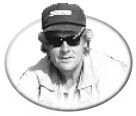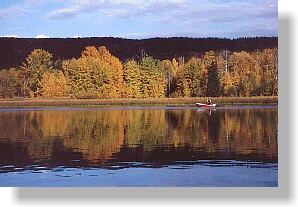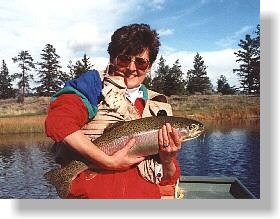
Of Shoals & Drop Offs
article and photos by Gordon Honey
SHOALS, the trout's grocery store, and
understanding the structure of shoals is crucial for the
fly angler, as 90%, of the Kamloops trout food is
derived from foraging these shoals. In our interior lakes
we are blessed with perhaps the finest shoals of any lake
systems in the world. Shoals are those areas that extend
from the shoreline to the drop-off, the drop-off being
either the gradual or sudden edge of the shoal that ends
in the deep-water zone of the lake.
 Back to drop-off in a moment. The shoal
area begins at the shoreline, typically a shore covered
by a tulle bed, reeds or bulrushes this area will be the
shallowest of the entire structure and is made up of
tulles and fallen timber at the shoreline, creates a
habitat for the small fish, fry and juveniles. Trout from
2 to 12 inches thrive and grow in these protected areas
of the shoal where food is abundant for them. As we move
further out onto the water the shoal gradually deepens,
the bottom is made up of noticeable patches of dark and
light, the dark being weeds such as chara the light
patches are mud or marl. The combination of these two
create a virtual food factory producing such foods as dragonfly, damsel, sedge and mayfly nymphs as well as shrimp and both chironomid
larvae and pupa and of course the ever present leeches.
Now back to the drop-off area or the
beginning of the deep-water zone of the lake. This area
is also food abundant, but more importantly provides an
emergency exit from the shallow water of the inner shoal.
If threatened by their predators loons, osprey and man they
can quickly escape to the dark of the deep water.
We can consider the drop-off as the
fish's freeway where they can travel, forage or simply
hang around waiting for a hatch to begin inside the
shoal. As these hatches such as mayflies and caddiesflies
begin the trout simply move in quickly and begin to feed.
The angler armed with a good pair of Polaroid sunglasses
can easily observe these foraging fish as they cruise in
these clearwater shoals. Remember the dark patches or
chara area, these areas not only provide food but
protection as well, the trout with their dark green backs
become almost invisible as they move silently onto these
dark patches, and therefore protected from the osprey.
Shoals because of their grocery store
quality provide we the flyfisher the best opportunity, to
catch our quarry, but to produce well conditions must be
right, if it is a flat clam day the trout will not move
onto the shoals and if they do they are extremely wary
and difficult to fool with an artificial fly. A light
breeze creates perfect conditions as it provides cover
for the trout from their aerial predators. Boat traffic
especially gas motors will chase the majority of trout
from the shoals. I'm sure you have had it happened to
you, you are anchored nicely on the shoal hooking the odd
fish and being observed by numerous trollers as you
continue to hook more fish they troll closer and closer
until guess what, the fish are now back out at the
drop-off, in hiding. I remember Jack Shaw telling me that
as the trollers move in, cast to the bow of their boat
and you will usually pick up the odd fish as they are
being pushed or herded by the trollers boat.
Back to shoals. Now that we have a
little understanding of shoals, let's consider how to
best approach them from an angling strategy.
 Perhaps
the best place to begin your day on the water is the
drop-off. Remember this is the fish's freeway where they
can move with some safety from the predators above, it is
not only a place of security but also is abundant in the
basic food chain, i.e., shrimp, leeches, dragon fly
nymphs etc. The drop-off zone is also a staging area,
trout will maintain a position here waiting for a major
hatch to occur. Positioning your craft, be it a boat or
tube, is critical in all aspects of successful angling.
It is however, always predicated by our friend and enemy
THE WIND. Perfect conditions for anchorage to approach
the drop-off would be a nice fife or breeze coming from
inside the shoal, in other words an offshore breeze. In
this scenario you would anchor half a cast back inside
the shoal allowing you to cast out into the deeper water
and retrieving back onto the shoal with the majority of
your retrieve contouring the grade of the drop-off from
deep to shallow and presenting your fly with maximum
effect. That scenario is somewhat utopic as we all know
as THE WIND will usually dictate our position. Scenario #
2 could very well be the norm with the breeze coming from
the deep water to the shoal. In this situation anchor
just outside the drop-off or right at the edge, allowing
you to cast along the edge of the drop-off quartering the
wind, i.e., if you are a right-hand caster then you would
cast with the wind off your left shoulder, in this way
the fly as you cast it does not become a missile bent on
attacking you or your companion. This position allows you
to maintain a retrieve always in the correct zone along
the edge of the shoal. Perhaps
the best place to begin your day on the water is the
drop-off. Remember this is the fish's freeway where they
can move with some safety from the predators above, it is
not only a place of security but also is abundant in the
basic food chain, i.e., shrimp, leeches, dragon fly
nymphs etc. The drop-off zone is also a staging area,
trout will maintain a position here waiting for a major
hatch to occur. Positioning your craft, be it a boat or
tube, is critical in all aspects of successful angling.
It is however, always predicated by our friend and enemy
THE WIND. Perfect conditions for anchorage to approach
the drop-off would be a nice fife or breeze coming from
inside the shoal, in other words an offshore breeze. In
this scenario you would anchor half a cast back inside
the shoal allowing you to cast out into the deeper water
and retrieving back onto the shoal with the majority of
your retrieve contouring the grade of the drop-off from
deep to shallow and presenting your fly with maximum
effect. That scenario is somewhat utopic as we all know
as THE WIND will usually dictate our position. Scenario #
2 could very well be the norm with the breeze coming from
the deep water to the shoal. In this situation anchor
just outside the drop-off or right at the edge, allowing
you to cast along the edge of the drop-off quartering the
wind, i.e., if you are a right-hand caster then you would
cast with the wind off your left shoulder, in this way
the fly as you cast it does not become a missile bent on
attacking you or your companion. This position allows you
to maintain a retrieve always in the correct zone along
the edge of the shoal.
When the hatch begins to happen on the
shoal itself, it is time to move in, no sense staying on
the freeway when the fish are in the grocery store!
Positioning yourself correctly is again
critical, if it is a mayfly or a caddis hatch it becomes
very apparent where the fish are as their riseforms give
them away. One important factor to remember, when there
is a breeze on the water, always position yourself
up-wind of the feeding zone as trout will always turn
their heads into the waves, simply because that breeze
and those waves are drifting the food to them so it is
important for you to make your cast to allow your fly to
be naturally drifted into the all important feeding zone.
One final tip, if a damsel hatch is on,
and this is the time of the season for them, they migrate
from the deeper water into the shoal heading for the
tulles where they will crawl up on to emerge as adults.
Your anchorage should therefore be well inside the shoal
allowing you to cast toward the drop-off so that your
retrieve mimics the migration path of to damsel nymphs.
Good luck out there in natures grocery store!!
Gordon Honey gordon@flyfishingservices.com
|





 Perhaps
the best place to begin your day on the water is the
drop-off. Remember this is the fish's freeway where they
can move with some safety from the predators above, it is
not only a place of security but also is abundant in the
basic food chain, i.e., shrimp, leeches, dragon fly
nymphs etc. The drop-off zone is also a staging area,
trout will maintain a position here waiting for a major
hatch to occur. Positioning your craft, be it a boat or
tube, is critical in all aspects of successful angling.
It is however, always predicated by our friend and enemy
THE WIND. Perfect conditions for anchorage to approach
the drop-off would be a nice fife or breeze coming from
inside the shoal, in other words an offshore breeze. In
this scenario you would anchor half a cast back inside
the shoal allowing you to cast out into the deeper water
and retrieving back onto the shoal with the majority of
your retrieve contouring the grade of the drop-off from
deep to shallow and presenting your fly with maximum
effect. That scenario is somewhat utopic as we all know
as THE WIND will usually dictate our position. Scenario #
2 could very well be the norm with the breeze coming from
the deep water to the shoal. In this situation anchor
just outside the drop-off or right at the edge, allowing
you to cast along the edge of the drop-off quartering the
wind, i.e., if you are a right-hand caster then you would
cast with the wind off your left shoulder, in this way
the fly as you cast it does not become a missile bent on
attacking you or your companion. This position allows you
to maintain a retrieve always in the correct zone along
the edge of the shoal.
Perhaps
the best place to begin your day on the water is the
drop-off. Remember this is the fish's freeway where they
can move with some safety from the predators above, it is
not only a place of security but also is abundant in the
basic food chain, i.e., shrimp, leeches, dragon fly
nymphs etc. The drop-off zone is also a staging area,
trout will maintain a position here waiting for a major
hatch to occur. Positioning your craft, be it a boat or
tube, is critical in all aspects of successful angling.
It is however, always predicated by our friend and enemy
THE WIND. Perfect conditions for anchorage to approach
the drop-off would be a nice fife or breeze coming from
inside the shoal, in other words an offshore breeze. In
this scenario you would anchor half a cast back inside
the shoal allowing you to cast out into the deeper water
and retrieving back onto the shoal with the majority of
your retrieve contouring the grade of the drop-off from
deep to shallow and presenting your fly with maximum
effect. That scenario is somewhat utopic as we all know
as THE WIND will usually dictate our position. Scenario #
2 could very well be the norm with the breeze coming from
the deep water to the shoal. In this situation anchor
just outside the drop-off or right at the edge, allowing
you to cast along the edge of the drop-off quartering the
wind, i.e., if you are a right-hand caster then you would
cast with the wind off your left shoulder, in this way
the fly as you cast it does not become a missile bent on
attacking you or your companion. This position allows you
to maintain a retrieve always in the correct zone along
the edge of the shoal.